TARCS: A Topology Change Aware-Based Routing Protocol Choosing Scheme of FANETs
Abstract
:1. Introduction
- The node motion is simplified to two-dimension movements.
- The transmission range of each node is a circular area with the node in the center and a radius of r. The transmission power of the node is constant within this area.
- The number of nodes in the network is constant during the network lifetime.
2. Related Work
2.1. Topology Change Perception Methods and Processing Methods
2.2. Discussion
- Neighbor node mobility trend prediction [12].
- Node mobility classification and decision making [14].
3. A Topology Change Aware Routing Protocol Choosing Scheme (TARCS)
3.1. Description
- It can monitor the topology changes around the nodes in real time.
- Nodes will respond to the perceived results in time and adjust to select the appropriate routing protocol.
- It will make the current routing protocol more suitable for node mobility mode and topology change requirements.
3.2. Periodically Topology Change Aware (PTCA)
- indicates the change in distance between node i and node j;
- indicates the change of direction between node i and node j;
- indicates the change of relative rate between node i and node j;
- is the weight coefficient: here .
3.3. Adaptive Routing Choosing Scheme (ARCS)
4. Evaluations and Results
4.1. Validation of TARCS
- In a complex scenario, using the TARCS strategy will have a certain impact on network performance.
- Using the same TARCS strategy at different node speeds has a different impact on network performance.
- In the TARCS strategy, the setting of TCDTH is very important and should be performed in advance.
4.2. Impact Analysis of Different TARCS Strategies on Network Performance
4.3. Validation of The Topology Change Awareness Method
- The TCDntwrk value is different when nodes move in the different patterns. As the number of groups decreases, the value of TCDntwrk gradually increases.
- In the same motion mode, the change of node speed has little effect on the TCDntwrk value.
4.4. Analysis of the Influence of Node Density on TCD
- For TCDi,j, the factors that affect its value include changes in velocity, direction, and distance between nodes.
- For TCDi,nbrs, in addition to each single TCDi,j value, the number of neighbor nodes within one hop is also one of the influencing factors.
- For TCDntwrk, the number of nodes in the network directly affects the value of TCDntwrk.
4.5. Disccusions
- Node cognition of its surroundings. Moving nodes can sense the topology environment between itself and neighboring nodes accurately and in a timely manner, thereby improving the node’s cognitive ability in regards to its environment.
- Adaptability. Nodes can adjust the routing protocol in real time according to the perceived result, and the adaptability of network is stronger.
- Scalability. The TARCS adaptive routing mechanism enables a FANET to adapt to changing scenarios. By modifying the topology change degree reference threshold/interval and adding alternate routing protocols, the TARCS can be extended to more scenarios and is compatible with more routing protocols.
5. Conclusions
- The topology change perception method can sense the topology changes of the network and distinguish several common mobility models of FANET.
- The combined use of routing protocols is more flexible and adaptable than using a single routing protocol in complex scenarios.
- Proper use of the TARCS scheme in complex scenarios can improve network performance.
Author Contributions
Funding
Conflicts of Interest
References
- Guillen-Perez, A.; Cano, M.D. Flying Ad Hoc Network: A New Domain for Network Communications. Sensors 2018, 18, 3571. [Google Scholar] [CrossRef] [PubMed]
- Bekmezci, İ.; Sahingoz, O.K.; Temel, Ş. Flying Ad-Hoc Networks (FANETs): A survey. Ad Hoc Netw. 2013, 11, 1254–1270. [Google Scholar] [CrossRef]
- Oubbati, O.M.; Lakas, A.; Zhou, F.; Güneş, M.; Yagoubi, M.B. A survey on position-based routing protocols for Flying Ad hoc Networks (FANETs). Veh. Commun. 2017, 10, 29–56. [Google Scholar] [CrossRef]
- Sarkar, S.K.; Basavaraju, T.G.; Puttamadappa, C. Routing Protocols. In Ad Hoc Mobile Wireless Networks-Principles, Protocols, and Applications, 2nd ed.; CRC Press: Boca Raton, FL, USA, 2012; pp. 81–126. [Google Scholar]
- Clausen, T.; Jacquet, P. Optimized Link State Routing Protocol (OLSR), RFC 3626 (Experimental). Available online: https://www.ietf.org/rfc/rfc3626.txt.pdf (accessed on 9 October 2018).
- Perkins, C.E.; Bhagwat, P. Highly Dynamic Destination-Sequenced Distance-Vector Routing (DSDV) for Mobile Computers. In Proceedings of the conference on Communications architectures, protocols and applications (SIGCOMM94), London, UK, 31 August–2 September 1994; pp. 234–244. [Google Scholar]
- Radhika Ranjan, R. Random Waypoint Mobility, Reference Point Group Mobility. In Handbook of Mobile Ad Hoc Networks for Mobility Models; Springer: Boston, MA, USA, 2011; pp. 637–670. [Google Scholar]
- Fan, B.; Sadagopan, N.; Helmy, A. The Important Framework for Analyzing the Impact of Mobility on Performance of Routing Protocols for Adhoc Networks. Ad Hoc Netw. 2003, 1, 383–403. [Google Scholar] [CrossRef]
- Hong, J.; Zhang, D. Impact Analysis of Node Motion on the performance of FANET routing protocols. In Proceedings of the 14th International Conference on Wireless Communications, Networking and Mobile Computing (WiCom2018), Chongqing, China, 18–20 September 2018. [Google Scholar]
- Sakhaee, E.; Jamalippour, A.; Kato, N. Aeronautical Ad Hoc Networks. In Proceedings of the IEEE Wireless Communications and Networking Conference (WCNC 2006), Las Vegas, NV, USA, 3–6 April 2006; pp. 246–251. [Google Scholar] [CrossRef]
- Zheng, Y.; Wang, Y.; Li, Z.; Dong, L.; Jiang, Y.; Zhang, H. A Mobility and Load aware OLSR routing protocol for UAV mobile ad-hoc networks. In Proceedings of the 2014 International Conference on Information and Communications Technologies (ICT2014), Nanjing, China, 15–17 May 2014. [Google Scholar]
- Zhou, J.H.; Lei, L.; Liu, W.K.; Tian, J. A simulation analysis of nodes mobility and traffic load aware routing strategy in aeronautical ad hoc networks. In Proceedings of the 2012 9th International Bhurban Conference on Applied Sciences & Technology (IBCAST), Islamabad, Pakistan, 9–12 January 2012; pp. 423–426. [Google Scholar]
- Hung, C.-C.; Chan, H.; Wu, E. Mobility Pattern Aware Routing for Heterogeneous Vehicular Networks. In Proceedings of the 2008 IEEE Wireless Communications and Networking Conference (WCNC2008), Las Vegas, NV, USA, 31 March–3 April 2008. [Google Scholar]
- Bamis, A.; Boukerche, A.; Chatzigiannakis, I.; Nikoletseas, S. A mobility aware protocol synthesis for efficient routing in ad hoc mobile networks. Comput. Netw. 2008, 52, 130–154. [Google Scholar] [CrossRef]
- Yu, Y.; Ru, L.; Chi, W.; Liu, Y.; Yu, Q.; Fang, K. Ant colony optimization based polymorphism-aware routing algorithm for ad hoc UAV network. Multimed. Tools Appl. 2016, 75, 14451–14476. [Google Scholar] [CrossRef]
- Swidana, A.; Abdelghanya, H.; Saifana, R.; Zilic, Z. Mobility and Direction Aware Ad-hoc on Demand Distance Vector Routing Protocol. Procedia Comput. Sci. 2016, 94, 49–56. [Google Scholar] [CrossRef] [Green Version]
- Khalaf, M.; Al-Dubai, Y.; Min, G. New efficient velocity-aware probabilistic route discovery schemes for high mobility Ad hoc networks. J. Comput. Syst. Sci. 2015, 81, 97–109. [Google Scholar] [CrossRef]
- Perkins, C.E.; Royer, E.M. Ad-hoc on-demand distance vector routing. In Proceedings of the Second IEEE Workshop on Mobile Computing Systems and Applications, New Orleans, LA, USA, 25–26 February 1999. [Google Scholar]
- Moussaoui, A.; Semchedine, F.; Boukerram, A. A link QoS routing protocol based on link stability for mobile ad hoc network. J. Netw. Comput. Appl. 2014, 39, 117–125. [Google Scholar] [CrossRef]
- Brahmbhatt, S.; Kulshrestha, A.; Singal, G. SSLSM: Signal Strength Based Link Stability Estimation in MANETs. In Proceedings of the 2015 International Conference on Computational Intelligence and Communication Networks, Jabalpur, India, 12–14 December 2015. [Google Scholar]
- Hong, X.; Gerla, M.; Pei, G.; Chiang, C.-C. A Group Mobility Model for Ad Hoc Wireless Networks. In Proceedings of the 2nd ACM international workshop on modeling, analysis and simulation of wireless and mobile systems, Seattle, WA, USA, 20 August 1999; pp. 53–60. [Google Scholar]
- Bonnmotion-A Mobility Scenario Generation and Analysis Tool. Available online: http://sys.cs.uos.de/bonnmotion/ (accessed on 10 October 2018).
- NS-3 Documentation. Available online: https://www.nsnam.org (accessed on 10 October 2018).
- Friis, H.T. A Note on a Simple Transmission Formula. Proc. IRE 1946, 34, 254–256. [Google Scholar] [CrossRef]
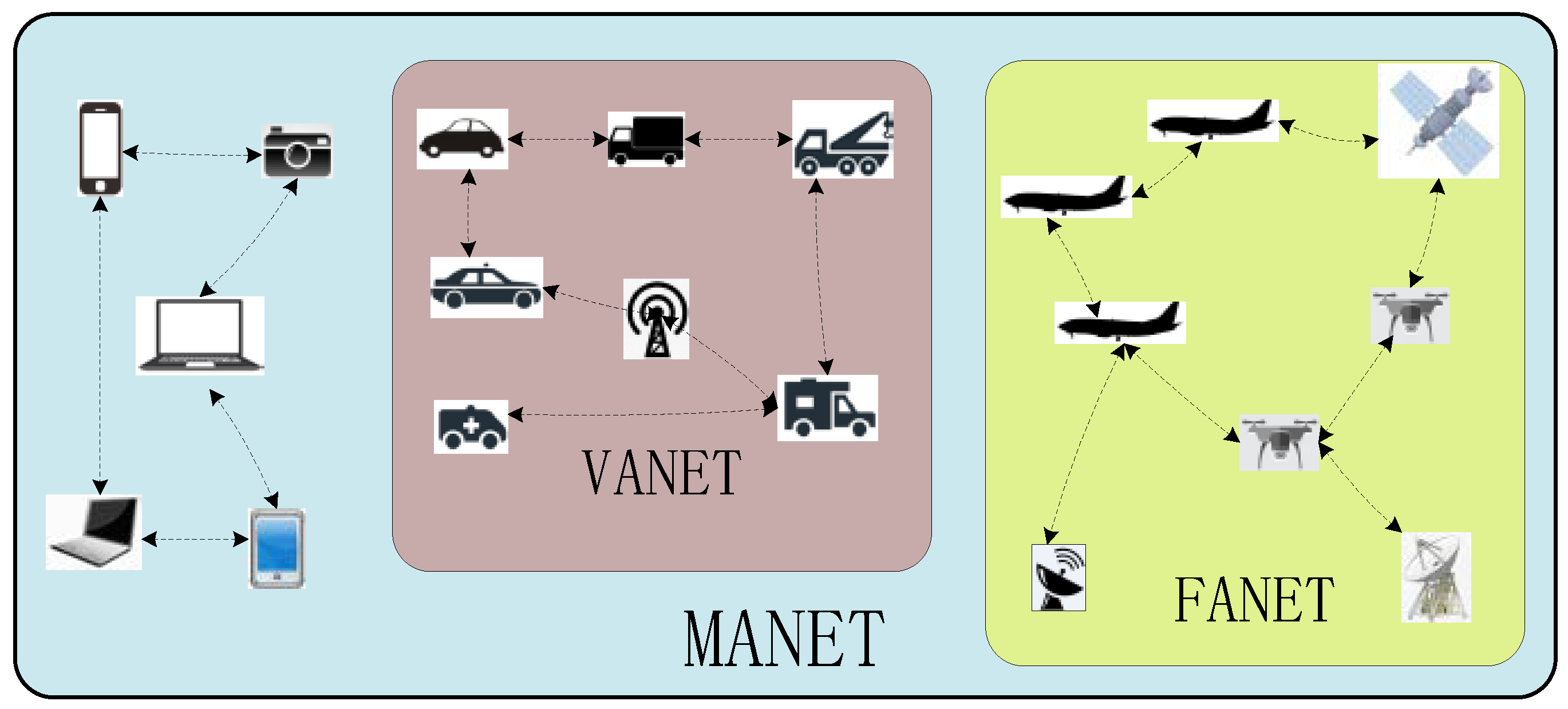
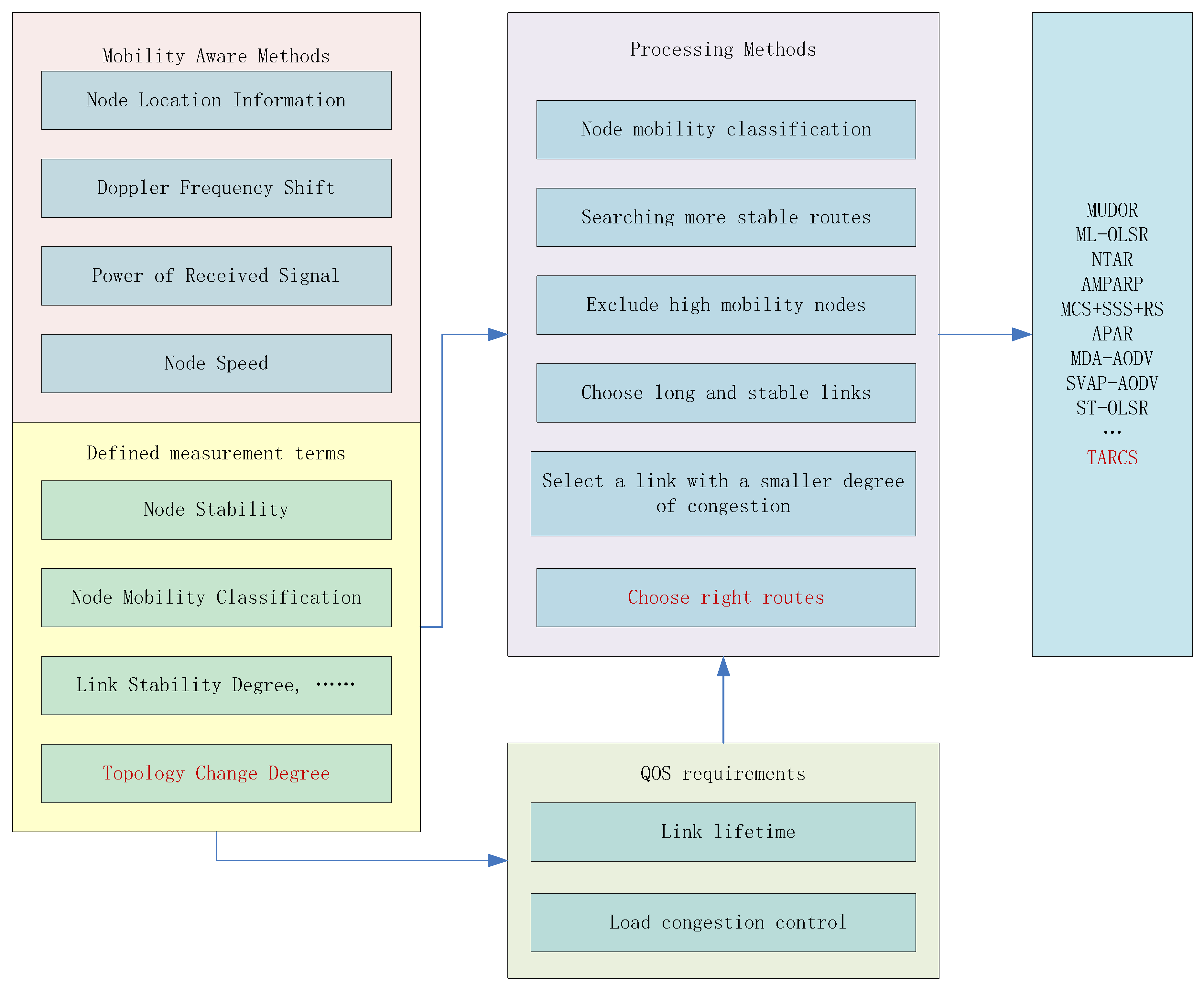

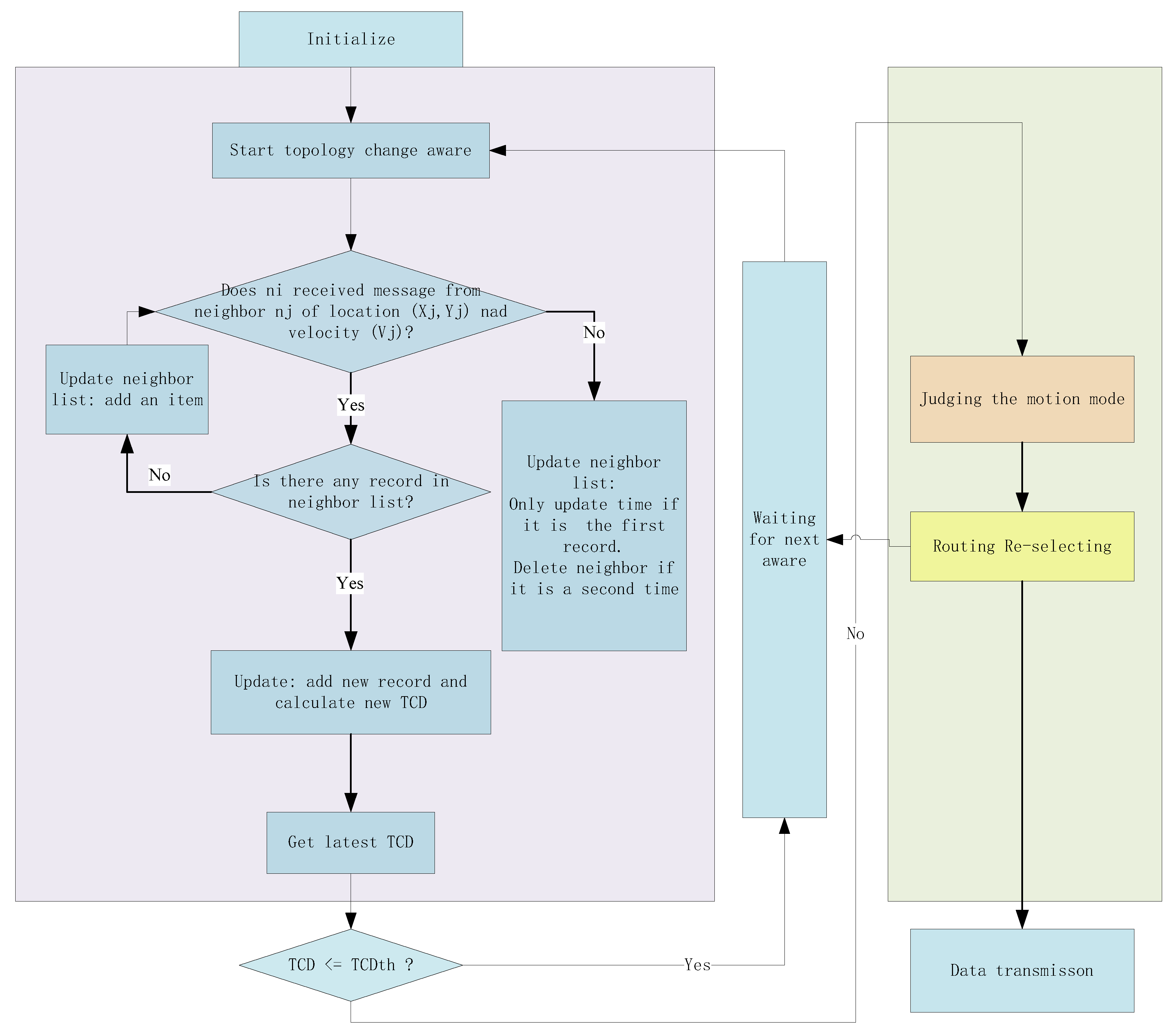
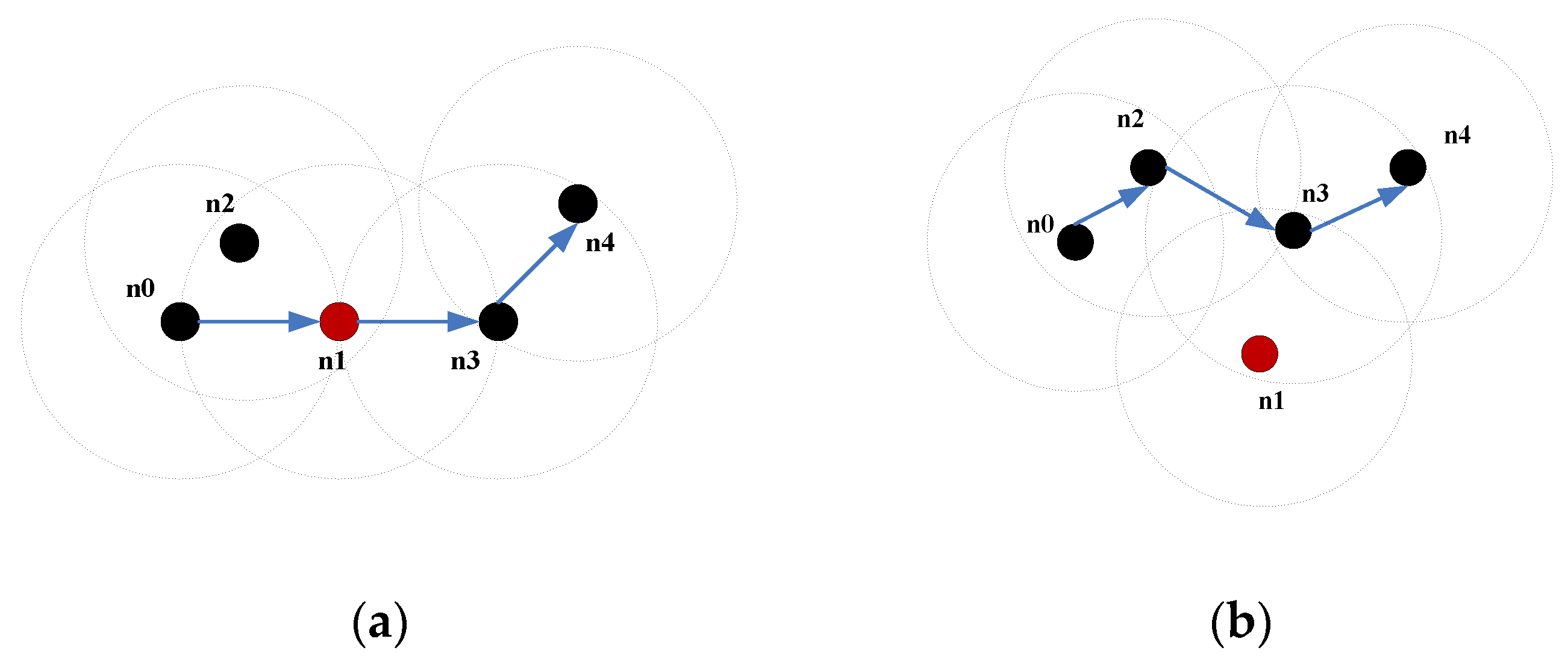
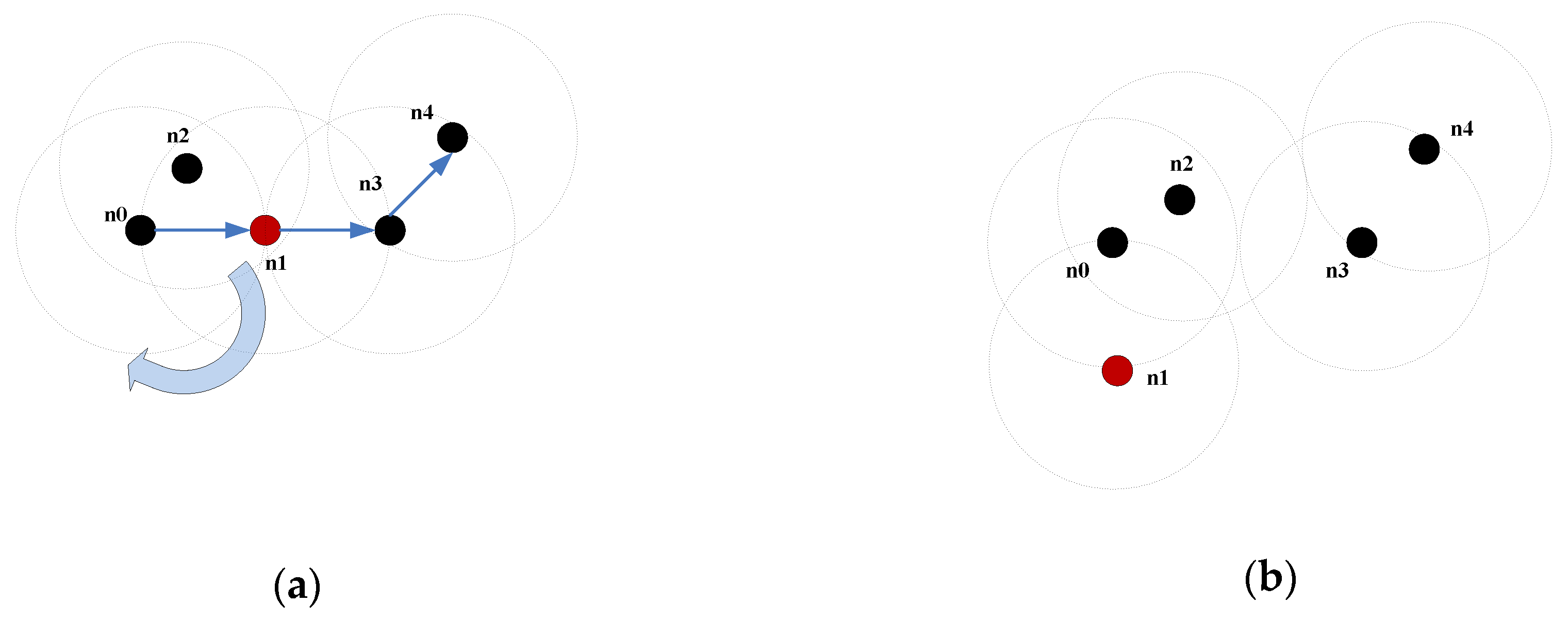
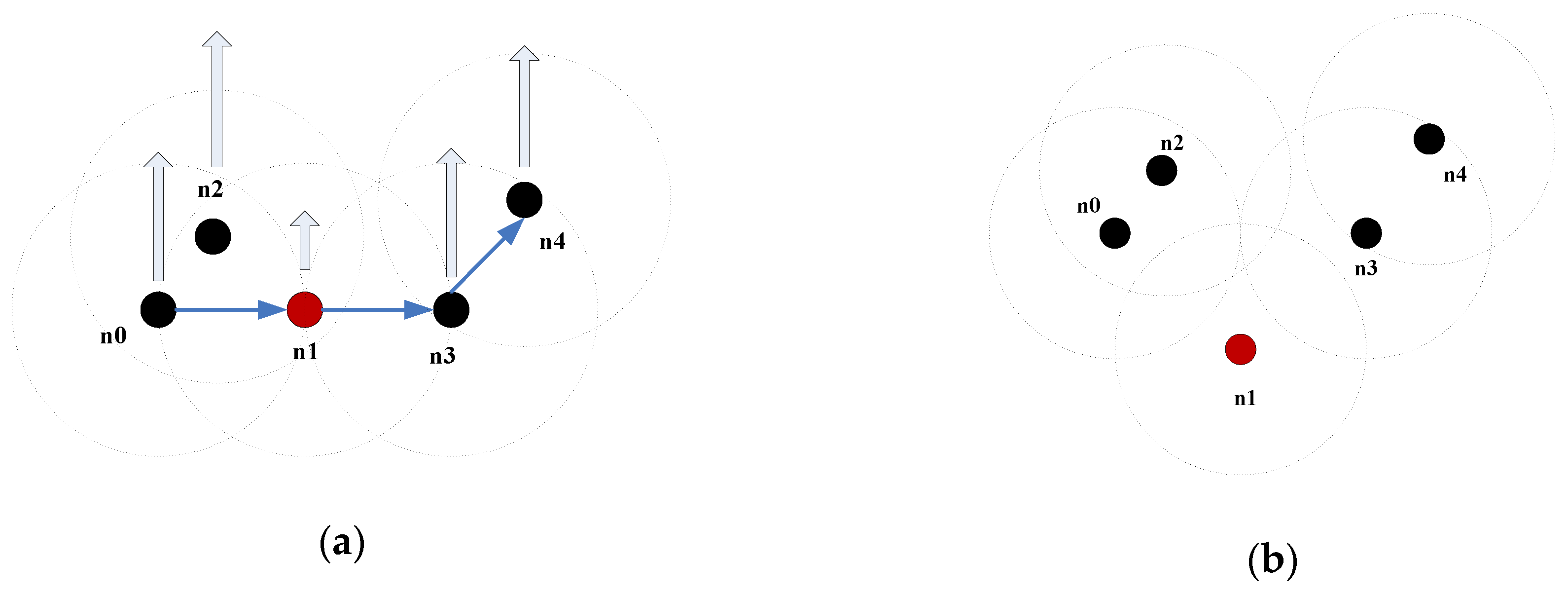


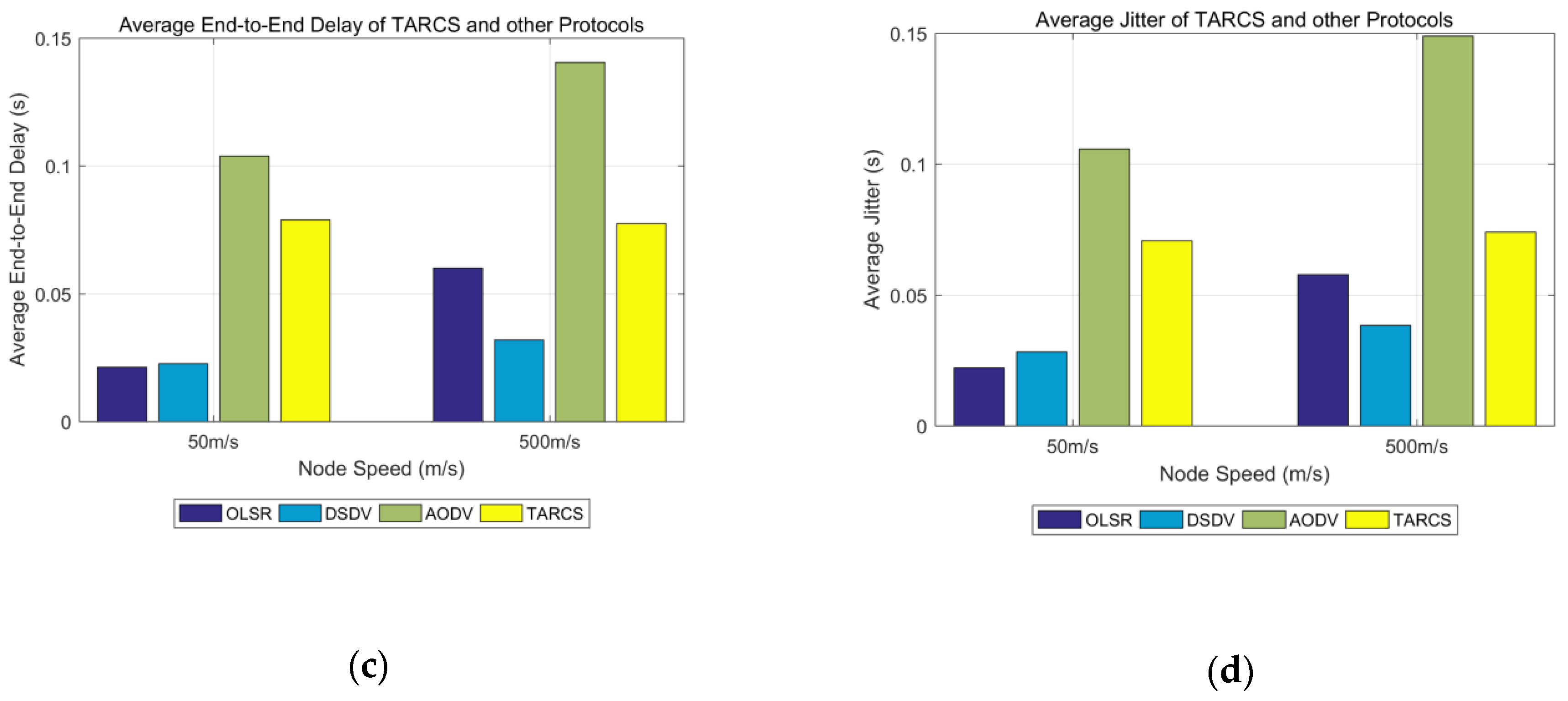
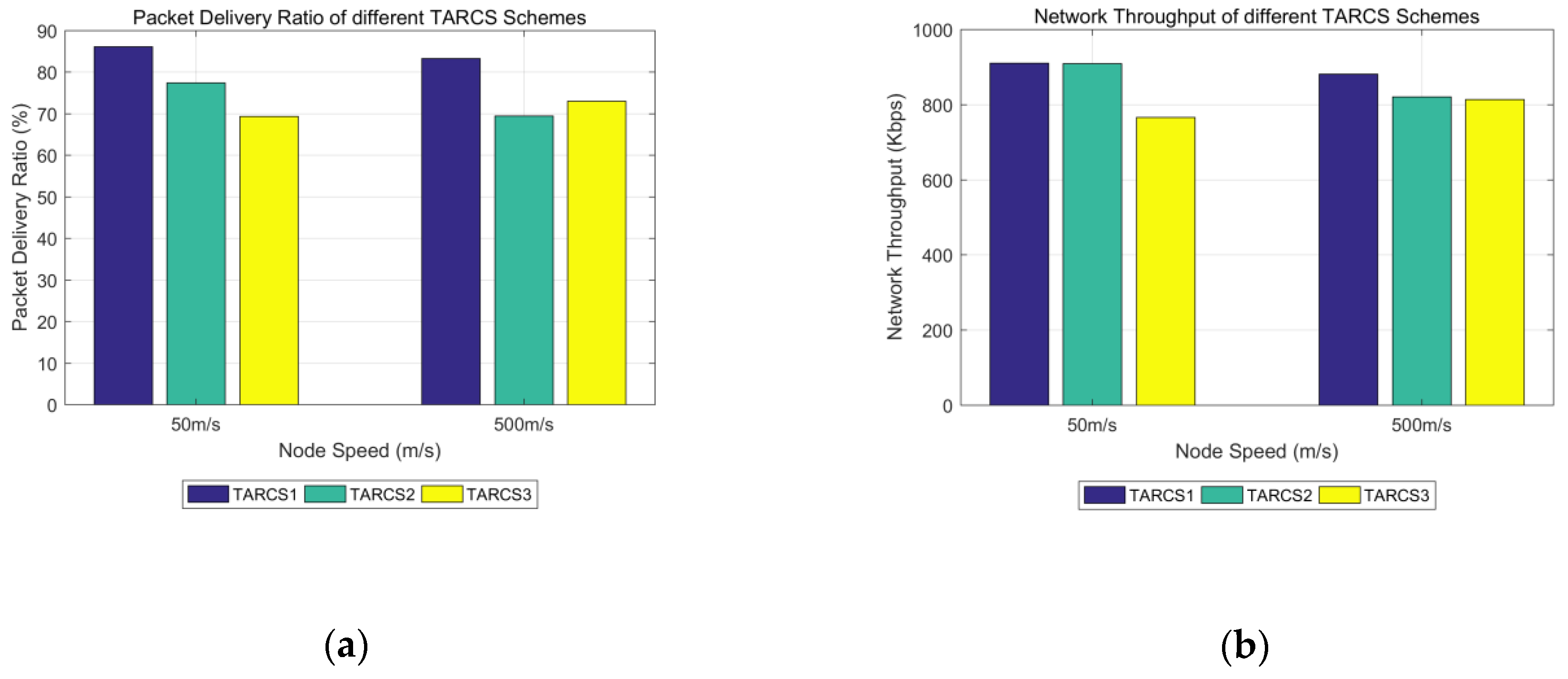


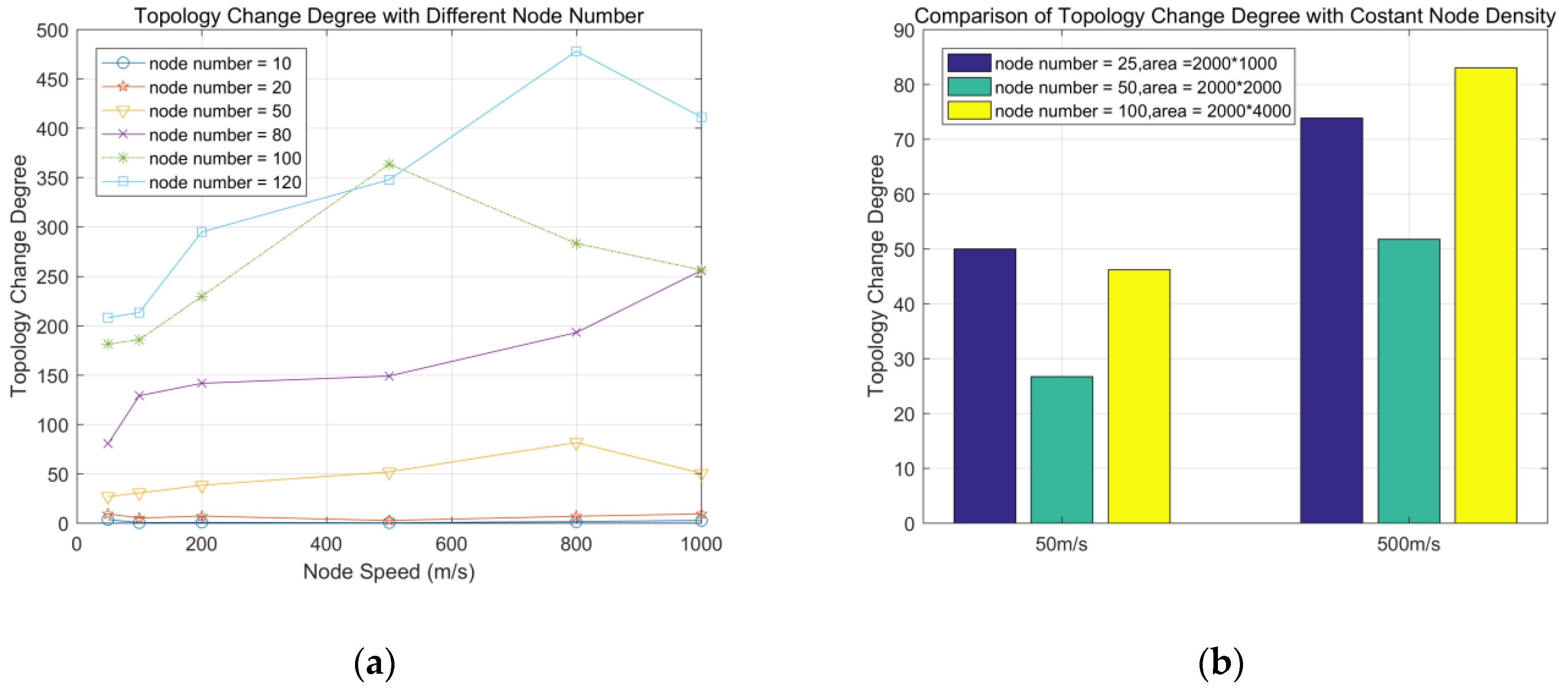
| Characteristics | MANET | VANET | FANET | |||
|---|---|---|---|---|---|---|
| Small UAVs | Large UAVs | |||||
| FW * | RW * | FW * | RW * | |||
| Node Speed | Low | Medium | Medium | Medium | High | High |
| Density | High | High | Low | |||
| Power Consumption | Low | High | Med | Med | High | High |
| Network Connectivity | High | Medium | Low | |||
| QoS | Medium | Depends on the applications | ||||
| Mobility Patterns | 2D | 2D | 3D | |||
| Mobility Degree | Low | Medium | Low-Med | Low-Med | Med-High | Med-High |
| Altitude | Close to ground | Close to ground | Low | Low | High | High |
| Static Pause | Yes | Yes | No | Yes | No | Yes |
| Topology Variation | Occasionally | Frequently | Very frequently | Very frequently | ||
| scalability | Medium | High | Low | |||
| Typical Mobility Models | regular | Restricted through roads | Depends on the applications and need to pre-determined | |||
| Parameters | Values |
|---|---|
| Simulation region | 2000 m × 2000 m |
| Node number | 50 |
| Mobility Model | Chain: RWP + RPGM (g = 5) + Pursue |
| Simulation Time | 602 s |
| Node speed | 50 m/s, 500 m/s |
| Route protocol | OLSR / AODV / DSDV |
| Propagation model | Free space propagation model |
| Delay model | constant speed propagation delay model |
| Data mode | CBR |
| Packet size | 1024 bytes |
| Data rate | 16 Kbps |
| MAC protocol | IEEE 802.11bDCF |
| Transmission range | 140 m |
| Perceptual Moment | Actual Mobility Model | Node Speed = 50 m/s | Node Speed = 500 m/s | Route Protocol | ||
|---|---|---|---|---|---|---|
| TCD(t) | Judged model | TCD(t) | Judged model | |||
| 0 | RWP | 0 | RWP | 0 | RWP | AODV |
| 50 | RWP | 2.078 | RWP | 0 | RWP | AODV |
| 100 | RWP | 15.459 | RWP | 842.592 | RWP | AODV |
| 150 | RWP | 34.364 | RWP | 782.536 | RWP | AODV |
| 200 | RPGM (g = 5) | 177.845 | RPGM | 589.106 | RWP | AODV |
| 250 | RPGM (g = 5) | 560.596 | RPGM | 2513.24 | Pursue | DSDV |
| 300 | RPGM (g = 5) | 658.254 | RPGM | 678.321 | RWP | AODV |
| 350 | RPGM (g = 5) | 493.418 | RPGM | 2102.88 | Pursue | DSDV |
| 400 | Pursue | 1963.96 | Pursue | 4144.1 | Pursue | DSDV |
| 450 | Pursue | 974.397 | RPGM | 2042.52 | Pursue | DSDV |
| 500 | Pursue | 3800.78 | Pursue | 2312.88 | Pursue | DSDV |
| 550 | Pursue | 2332.39 | Pursue | 4482.67 | Pursue | DSDV |
| 600 | Pursue | 4786.97 | Pursue | 3666.45 | Pursue | DSDV |
| Mobility Model | TARCS1 | TARCS2 | TARCS3 |
|---|---|---|---|
| RWP | AODV | OLSR | AODV |
| RPGM (g = 5) | AODV | AODV | DSDV |
| Pursue | DSDV | DSDV | DSDV |
| Types of Route Protocols | Characteristics | Advantages | Disadvantages |
|---|---|---|---|
| Proactive routing protocol | Periodically maintain routing links; suitable for small networks. | Short delay; high quality of service; long-pass link. | High energy consumption; heavy network load and high node congestion level. |
| Reactive routing protocol | Establish routing discovery when needed. | Low energy consumption; light routing load. | The pass-link is not guaranteed. It takes time to establish a link. Once the link is interrupted, it needs to be re-established. |
| Hybrid routing protocol | Combined with proactive and reactive routing. Suitable for hierarchical networks. | Using proactive routing within the cluster, reactive between clusters | Only suitable for hierarchical networks. |
| Topology-change-driven protocol | Reselect the appropriate route based on topology changes. | Nodes obtain information of the surrounding topology changes in time. Multiple routing protocols are used in combination to suit complex scenarios. | Dependent on reference threshold settings and specific routing strategies. |
© 2019 by the authors. Licensee MDPI, Basel, Switzerland. This article is an open access article distributed under the terms and conditions of the Creative Commons Attribution (CC BY) license (http://creativecommons.org/licenses/by/4.0/).
Share and Cite
Hong, J.; Zhang, D. TARCS: A Topology Change Aware-Based Routing Protocol Choosing Scheme of FANETs. Electronics 2019, 8, 274. https://doi.org/10.3390/electronics8030274
Hong J, Zhang D. TARCS: A Topology Change Aware-Based Routing Protocol Choosing Scheme of FANETs. Electronics. 2019; 8(3):274. https://doi.org/10.3390/electronics8030274
Chicago/Turabian StyleHong, Jie, and Dehai Zhang. 2019. "TARCS: A Topology Change Aware-Based Routing Protocol Choosing Scheme of FANETs" Electronics 8, no. 3: 274. https://doi.org/10.3390/electronics8030274





